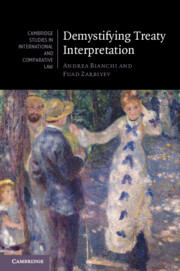Book contents
- Demystifying Treaty Interpretation
- Cambridge Studies in International and Comparative Law: 188
- Demystifying Treaty Interpretation
- Copyright page
- Contents
- Figures
- Preface
- Abbreviations
- 1 The Province of the Rules of Treaty Interpretation
- 2 The Interpreter’s Self
- 3 The Genealogy of the Contemporary Regime of Treaty Interpretation
- 4 Textualism
- 5 Intentionalism
- 6 What’s the Purpose of ‘Object and Purpose’?
- 7 Supplementary Means
- 8 The Magic of Systemic Integration
- 9 Inferential Reasoning and Its Consequences
- 10 Time and Treaty Interpretation
- 11 Text, Author, and Interpretive Control
- 12 Power, Persuasion, and Authority
- Annex Vienna Convention on the Law of Treaties 1969
- Index
- Cambridge Studies in International and Comparative Law
10 - Time and Treaty Interpretation
Published online by Cambridge University Press: 07 March 2024
- Demystifying Treaty Interpretation
- Cambridge Studies in International and Comparative Law: 188
- Demystifying Treaty Interpretation
- Copyright page
- Contents
- Figures
- Preface
- Abbreviations
- 1 The Province of the Rules of Treaty Interpretation
- 2 The Interpreter’s Self
- 3 The Genealogy of the Contemporary Regime of Treaty Interpretation
- 4 Textualism
- 5 Intentionalism
- 6 What’s the Purpose of ‘Object and Purpose’?
- 7 Supplementary Means
- 8 The Magic of Systemic Integration
- 9 Inferential Reasoning and Its Consequences
- 10 Time and Treaty Interpretation
- 11 Text, Author, and Interpretive Control
- 12 Power, Persuasion, and Authority
- Annex Vienna Convention on the Law of Treaties 1969
- Index
- Cambridge Studies in International and Comparative Law
Summary
There are a number of ways in which time affects treaty interpretation. This chapter examines how a text can be understood, in Roland Barthes’s famous expression, as a ‘weapon against time’ (i.e. a device of stability). In international law, such understanding of a text as a safeguard against change is rooted in the principle of contemporaneity, according to which the terms of a treaty shall be interpreted according to the meaning prevailing at the time of its conclusion. Nevertheless, an exception to this principle has emerged in the form of the doctrine of evolutionary interpretation. This chapter thus looks at the ways in which lawyers navigate the tensions between stability and the perceived need for law to respond and adapt to changing social circumstances and present-day conditions. The chapter then turns to the question of subsequent practice and, more precisely, what should be meant by ‘practice’. It also seeks to illuminate the stakes of the debate about the ultimately rejected draft Article 38 of the Vienna Convention, which provided for the possibility of the modification of a treaty by subsequent practice. Finally, the chapter also broaches the question of the boundary between interpretation, law-making, and the emergence of a new rule of customary international law.
- Type
- Chapter
- Information
- Demystifying Treaty Interpretation , pp. 199 - 232Publisher: Cambridge University PressPrint publication year: 2024

